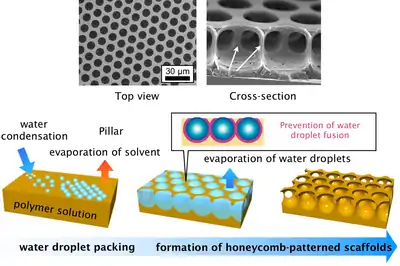Breath-figure self-assembly
Breath-figure self-assembly is the self-assembly process of formation of honeycomb micro-scaled polymer patterns by the condensation of water droplets. "Breath-figure" refers to the fog that forms when water vapor contacts a cold surface.[1][2][3] In the modern era systematic study of the process of breath-figures water condensation was carried out by Aitken[4][5] and Rayleigh,[6][7] among others. Half a century later the interest to the breath-figure formation was revived in a view of study of atmospheric processes, and in particular the extended study of a dew formation which turned out to be a complicated physical process. The experimental and theoretical study of dew formation has been carried out by Beysens.[8][9][10] Thermodynamic and kinetic aspects of dew formation, which are crucial for understanding of formation of breath-figures inspired polymer patterns will be addressed further in detail.


Breakthrough in the application of the breath-figures patterns was achieved in 1994–1995 when Widawski, François and Pitois reported manufacturing of polymer films with a self‐organized, micro-scaled, honeycomb morphology using the breath-figures condensation process.[11][12] The reported process was based on the rapidly evaporated polymer solutions exerted to humidity.[13][14][15] The introduction into experimental techniques involved in manufacturing of micropatterned surfaces is supplied in reference 1; image representing typical breath-figures-inspired honeycomb pattern is shown in Figure 1.
The main physical processes involved in the process are: 1) evaporation of the polymer solution; 2) nucleation of water droplets; 3) condensation of water droplets; 4) growth of droplets; 5) evaporation of water; 6) solidification of polymer giving rise to the eventual micro-porous pattern.[16] This experimental technique allows obtaining well-ordered, hierarchical, honeycomb surface patterns.[13][16] A variety of experimental techniques were successfully exploited for the formation of breath-figures self-assembly induced patterns including drop-casting, dip-coating and spin-coating.[2][15] Hierarchical patterning occurring under breath-figures self-assembly was reported. The characteristic dimension of pores is usually close to 1 µm, whereas the characteristic lateral dimension of the large-scale patterns is ca. 10–50 µm.[2]
See also
References
- Rodríguez-Hernández, Juan; Bormashenko, Edward (2020). Breath Figures: Mechanisms of Multi-scale Patterning and Strategies for Fabrication and Applications of Microstructured Functional Porous Surfaces. Cham: Springer International Publishing. doi:10.1007/978-3-030-51136-4. ISBN 978-3-030-51135-7.
- Yabu, Hiroshi (2018). "Fabrication of honeycomb films by the breath figure technique and their applications". Science and Technology of Advanced Materials. 19: 802–822. doi:10.1080/14686996.2018.1528478.

- Zhang, Aijuan; Bai, Hua; Li, Lei (2015). "Breath Figure: A Nature-Inspired Preparation Method for Ordered Porous Films". Chemical Reviews. 115 (18): 9801–9868. doi:10.1021/acs.chemrev.5b00069. PMID 26284609.
- Aitken, John (1893). "Breath Figures" (PDF). Proceedings of the Royal Society of Edinburgh. 20: 94–97. doi:10.1017/S0370164600048434.
- Aitken, John (1911). "Breath Figures". Nature. 86 (2172): 516–517. doi:10.1038/086516a0.
- Rayleigh, Lord (1911). "Breath Figures". Nature. 86 (2169): 416–417. doi:10.1038/086416d0.
- Rayleigh, Lord (1912). "Breath Figures". Nature. 90 (2251): 436–438. doi:10.1038/090436c0.
- Beysens, D.; Steyer, A.; Guenoun, P.; Fritter, D.; Knobler, C. M. (1991). "How does dew form?". Phase Transitions. 31 (1–4): 219–246. doi:10.1080/01411599108206932.
- Beysens, D. (1995). "The formation of dew". Atmospheric Research. 39 (1–3): 215–237. doi:10.1016/0169-8095(95)00015-j.
- Beysens, Daniel (2006). "Dew nucleation and growth". Comptes Rendus Physique. 7 (9–10): 1082–1100. doi:10.1016/j.crhy.2006.10.020.
- Widawski, Gilles; Rawiso, Michel; François, Bernard (1994). "Self-organized honeycomb morphology of star-polymer polystyrene films". Nature. 369 (6479): 387–389. doi:10.1038/369387a0.
- François, Bernard; Pitois, Olivier; François, Jeanne (1995). "Polymer films with a self-organized honeycomb morphology". Advanced Materials. 7 (12): 1041–1044. doi:10.1002/adma.19950071217.
- Bunz, U. H. F. (2006). "Breath Figures as a Dynamic Templating Method for Polymers and Nanomaterials". Advanced Materials. 18 (8): 973–989. doi:10.1002/adma.200501131.
- Muñoz-Bonilla, Alexandra; Fernández-García, Marta; Rodríguez-Hernández, Juan (2014). "Towards hierarchically ordered functional porous polymeric surfaces prepared by the breath figures approach". Progress in Polymer Science. 39 (3): 510–554. doi:10.1016/j.progpolymsci.2013.08.006. hdl:10261/98768.
- Bormashenko, Edward (2017). "Breath-Figure Self-Assembly, a Versatile Method of Manufacturing Membranes and Porous Structures: Physical, Chemical and Technological Aspects". Membranes. 7 (3): 45. doi:10.3390/membranes7030045. PMC 5618130. PMID 28813026.
- Srinivasarao, Mohan; Collings, David; Philips, Alan; Patel, Sanjay (2001). "Three-Dimensionally Ordered Array of Air Bubbles in a Polymer Film". Science. 292 (5514): 79–83. doi:10.1126/science.1057887. PMID 11292866.